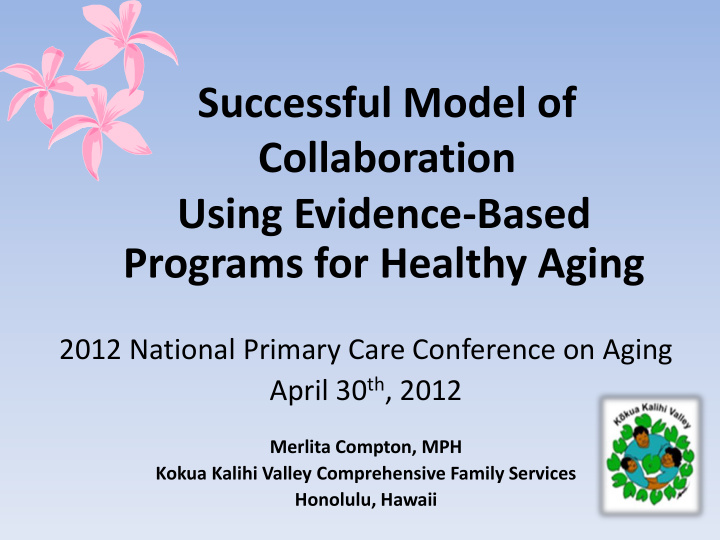



Successful Model of Collaboration Using Evidence-Based Programs for Healthy Aging 2012 National Primary Care Conference on Aging April 30 th , 2012 Merlita Compton, MPH Kokua Kalihi Valley Comprehensive Family Services Honolulu, Hawaii
Community Characteristics – Kalihi Valley Community 10% 8% 31% Filipino 7% Micronesian Samoan Hawaiian 20% East Asian 24% Other Health Insurance 43%: Medicaid 0-100% of 37%: Uninsured 25% poverty level 15%: Private 101-150% of 5%: Medicare 3% poverty level 2% 63% 151- 200% of 7% poverty level over 200% of poverty level
Overview of Kokua Kalihi Valley Comprehensive Family Services (sites and locations)
Kokua Kalihi Valley Elder Services • Located in urban area • 6 staff • Provides: o Case Management o Health Maintenance o Health Screening o Caregiver Support Services o Evidence-based health promotion programs o Medical, Dental, Behavioral Clinic Serve older adults (60+); Majority are immigrants • (n=526)
To help elders improve their health, KKV has participated in Statewide Healthy Aging Initiative • Invited to participate in Statewide Healthy Aging Initiative in 2007 – Co-led by State Unit on Aging and Department of Health (partners from 64 organizations & 27 volunteers) – Goal is to improve the health status of older adults through evidence-based health promotion programs
Stanford’s Self -Management Programs (CDSMP) • Three different types are available: Chronic Disease, Diabetes, & Arthritis • 2.5 hrs./wk. for 6 weeks • Led by two-person teaching teams • Purpose — To empower people with chronic conditions to take charge in managing and controlling their symptoms — To increase knowledge of techniques and improve skills for more effective symptom self-management
CDSMP is not only improving health, but also lowering costs, and reducing utilization • Visits to doctors and ER = 8 % • Hospital Days = 40 % • Two year savings = $390 - $520 per participant – Based on reduced hospitalizations and outpatient visits, using a program cost of $70 - $200 per participant. • Data yield a cost to savings ratio of approximately 1:10. Many of these results persist for as long as three years.*** ***OUTCOME DATA REPORTED IN: LORIG KR, SOBEL DS, STEWART AL, BROWN JR BW, RITTER PL, GONZÁLEZ VM, LAURENT DD, HOLMAN HR. EVIDENCE SUGGESTING THAT A CHRONIC DISEASE SELF-MANAGEMENT PROGRAM CAN IMPROVE HEALTH STATUS WHILE REDUCING UTILIZATION AND COSTS: A RANDOMIZED TRIAL. MEDICAL CARE , 37(1):5-14, 1999. & LORIG KR, RITTER P, STEWART AL, SOBEL DS, BROWN BW, BANDURA A, GONZÁLEZ VM, LAURENT DD, HOLMAN HR. CHRONIC DISEASE SELF-MANAGEMENT PROGRAM: 2-YEAR HEALTH STATUS AND HEALTH CARE UTILIZATION OUTCOMES. MEDICAL CARE , 39(11),1217-1223, 2001. & • IN HMO SETTING: LORIG KR, SOBEL DS, RITTER PL, LAURENT D, HOBBS M. EFFECT OF A SELF-MANAGEMENT PROGRAM ON PATIENTS WITH CHRONIC DISEASE. EFFECTIVE CLINICAL PRACTICE , 4(6),256-262, 2001.
KKV has served 216 participants in CDSMP Trained Conducted DSMP Eval Partnership Trained in ASMP Started more staff CDSMP Project & DSMP in CDSMP Training Trained more Trained in Trained staff in CDSMP CDSMP more staff in DSMP Implement CDSMP Implement ASMP & DSMP
Adaptation Process: Step 1 Examine the Program • Does the program fit with our clients? – What components do we need to modify?: Use “Track change tool” Adapted from: Peterson, E. W. (2003). Using cognitive behavioral strategies to reduce fear of falling: A matter of balance. Generations . 26(4): 53 • In addition to this, we used “Adaptation traffic light tool” – Red light adaptations – DO NOT CHANGE – Yellow light adaptations – ADAPT WITH CAUTION – Green light adaptations – GO AHEAD!
Adaptation Process: Step 2 Try Out “Green & Yellow lights” Modifications • Offer “informational session” before the workshop • Provide additional support outside of class time Supplemental booklet in their native language (Hawaiian, Ilocano, Chinese, etc)
Adaptation Process: Step 2 Try Out “Green & Yellow lights” Modifications • Encourage participants to complete the workshop • Plan event to collect 6-month follow-up data
Adaptation Process: Step 3 Evaluate program • Ensure fidelity of program delivery – Evaluator visits one session out of 6 sessions 2 pages evaluation: Assess 10 major components Scored 1-4, higher score indicates high fidelity
Adaptation Process: Step 3 Evaluate program • Ensure client profiles reflect our community (n=196) – Mean Age was 72.7 years & 83% were female – 68% had English Limitation – 39% had Medicaid
Adaptation Process: Step 3 Evaluate program 0-5 (lower number = less communication) Before 6-month Physician ER Hospital Contacts in the past 6-months Minutes per week
Anecdotal Story From KKV’s participant “I learned many things from KKV DSMP workshops, I am doing what I learned to help me better manage my emotions, my medications, and everyday tasks. With an action plan I am able to make choices, to eat healthier food, and accomplished my goal of having a normal life. Setting my action plan and by eating healthy, exercising regularly, communicating with my doctor and my family members makes my life easier. I learned that eating healthy foods with smaller portions, in the right time, and eating healthy snacks, improved my health and for sure makes it easier for me in dealing with my Diabetes. I lost 8 pounds in the past six weeks by following and accomplishing my action plan I set every week. I know that I can still live a healthy life even with Diabetes. KKV staff patiently teaches us to learn many helpful things and my fellow participants are very helpful because each member shares experiences how to make good choices that are applicable and meaningful in the many situations I face. I am very, very thankful and encouraged to continue these changes. I am very happy and I find a smile in my face”. Wilhelmina, 3/6/2012
Lessons Learned • Beneficial to join with the Statewide partnership • Using adaptation tools helpful in ensuring benefit of CDSMP for our clients • Monitoring is critical • Potentially could save participants medical care costs
Questions? • Contact Information: – Merlita Compton – mcompton@kkv.net – (808) 848-0977
Recommend
More recommend